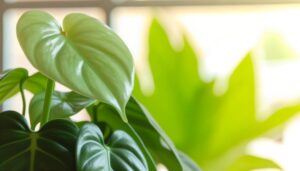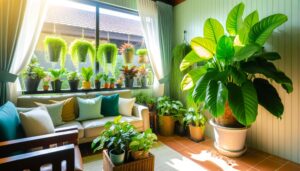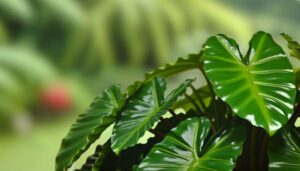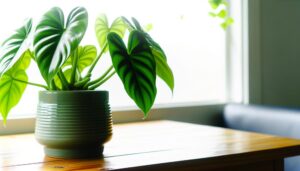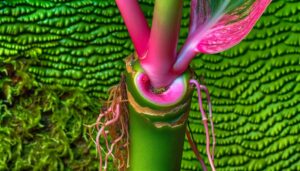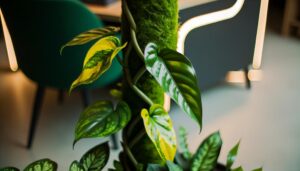What Are the Characteristics of Philodendron Hederaceum 'Tricolor'?
Philodendron hederaceum 'Tricolor' is characterized by heart-shaped leaves displaying variegation in green, cream, and pink tones, outcomes of unique chlorophyll distribution patterns. This species adopts a climbing growth habit supported by aerial roots, suitable for vertical gardening or hanging baskets.
It thrives in bright, indirect light and prefers well-draining, consistently moist soil. Best temperatures range from 18-24°C, with humidity levels maintained between 60-80%.
Fertilization every other month with a balanced 20-20-20 N-P-K ratio is advisable, and propagation primarily occurs through stem cuttings to maintain genetic variegation. Exploring further will reveal additional insight into ideal care practices.
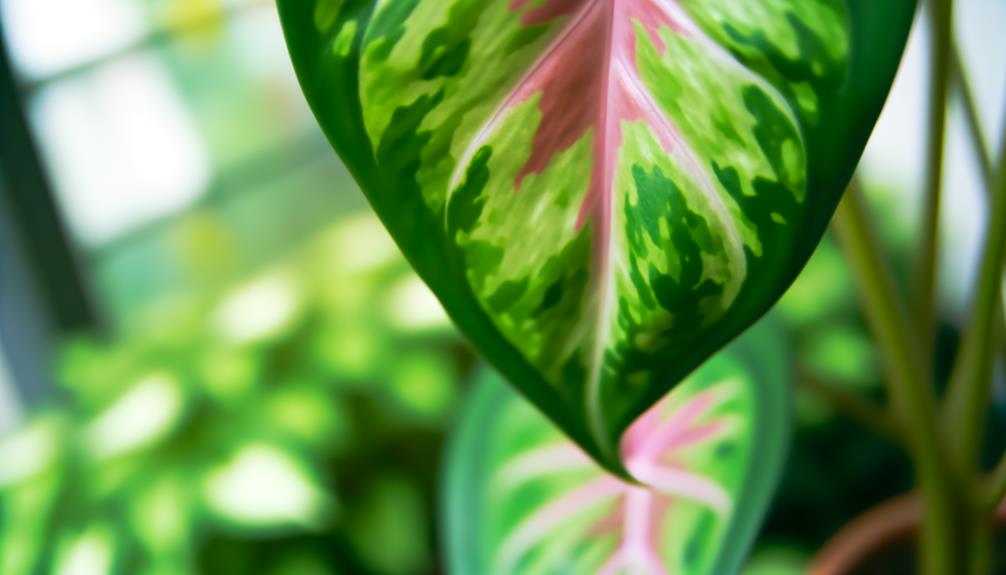
Key Takeaways
- Heart-shaped leaves with green, cream, and pink variegation.
- Climbing growth habit supported by aerial roots.
- Prefers bright, indirect sunlight and well-draining soil.
- Requires consistent moisture but not waterlogged soil.
- Propagated mainly through stem cuttings to maintain variegation.
Leaf Coloration
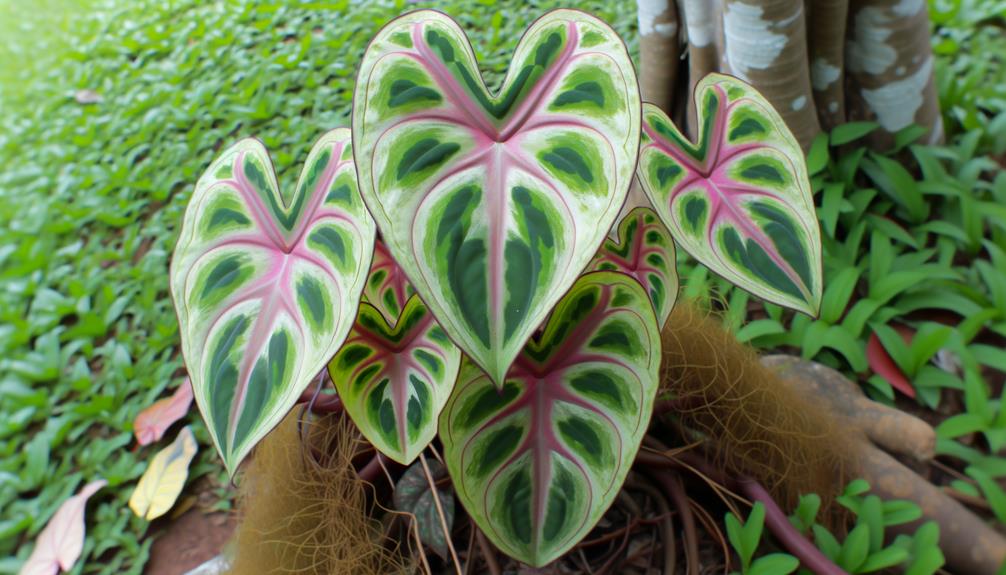
The leaf coloration of Philodendron hederaceum 'Tricolor' is characterized by a striking variegation, featuring a blend of green, cream, and pink hues. This variegation results from the uneven distribution of chlorophyll within the foliage, giving rise to the unique patterns observed in each leaf.
The green sections are rich in chlorophyll, essential for photosynthesis, while the cream and pink areas contain reduced chlorophyll levels, revealing underlying pigments such as anthocyanins. These pigments not only contribute to the aesthetic appeal but also play roles in photoprotection and stress responses.
The variegation pattern is genetically determined and can vary remarkably from leaf to leaf, making each specimen of Philodendron hederaceum 'Tricolor' distinct and visually appealing.
Leaf Shape
The Philodendron hederaceum 'Tricolor' is distinguished by its heart-shaped leaves, which exhibit a striking variegation. Each leaf typically features a blend of green, cream, and pink hues, contributing to its unique aesthetic appeal.
The foliage's intricate patterning and vibrant coloration underscore the plant's ornamental value in both domestic and commercial horticultural settings.
Heart-Shaped and Vibrant
Philodendron hederaceum 'Tricolor' exhibits distinctly heart-shaped leaves, which are a hallmark of its morphological characteristics, showcasing vibrant variegation that includes shades of green, cream, and pink. The leaves' unique shape and coloration are not only aesthetically pleasing but also serve specific biological functions.
These heart-shaped leaves are:
- Adaptive: Designed to maximize photosynthesis by capturing sunlight efficiently.
- Aesthetic: Their symmetrical, heart-like contours enhance the plant's ornamental value.
- Protective: Their broad surface area helps in shading and cooling the plant, reducing water loss.
Philodendron hederaceum 'Tricolor' exemplifies the synergy between function and form, making it a sought-after specimen for both botanical collections and ornamental horticulture. Understanding these leaf characteristics aids in its cultivation and care.
Variegated Color Patterns
Displaying a complex interplay of chlorophyll and anthocyanins, the diverse color patterns of Philodendron hederaceum 'Tricolor' are characterized by striking combinations of green, cream, and pink hues. This variegation stems from the differential expression of pigments, resulting in visually enchanting leaves.
The green sections are rich in chlorophyll, supporting photosynthesis, while the cream areas lack chlorophyll, often due to genetic mutations or chimeric tissue. Pink areas emerge from the presence of anthocyanins, which offer additional light protection and enhance the plant's decorative charm.
These variegated designs are not just visually pleasing; they demonstrate intricate physiological processes and genetic variations, making the 'Tricolor' a distinct specimen within the Araceae plant family. Understanding these patterns can assist in cultivating practices that are most beneficial.
Growth Habit
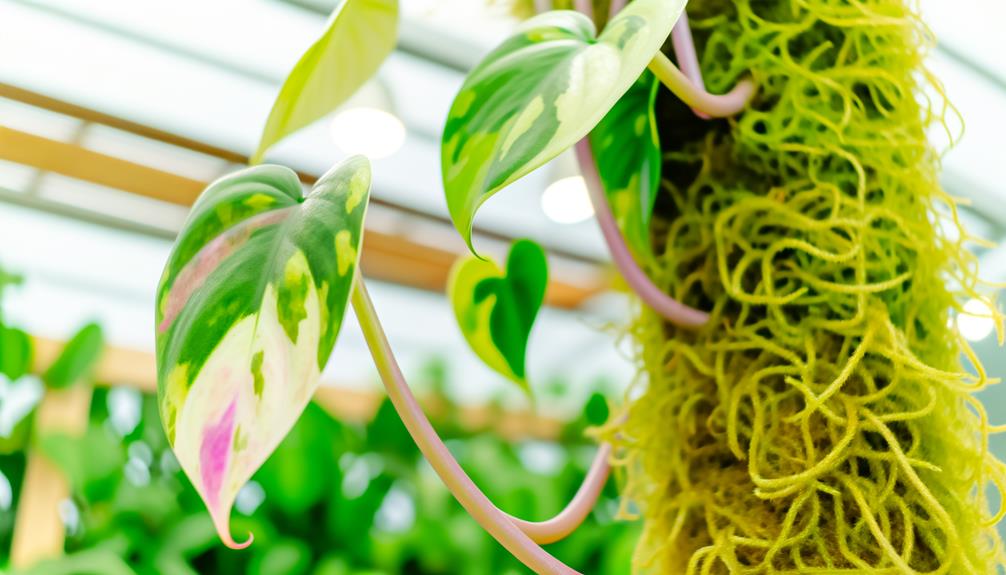
Characterized by its vining nature, Philodendron hederaceum 'Tricolor' displays a climbing growth habit facilitated by aerial roots that adhere to various substrates. The plant exhibits a robust, rapid growth rate, making it suitable for vertical gardening or as a trailing plant in hanging baskets.
Its stems, which can extend several meters, support heart-shaped leaves with striking variegation.
Key growth habit features include:
- Climbing Mechanism: Utilizes adventitious roots to anchor onto tree trunks, moss poles, or other structures.
- Trailing Capability: Ideal for cascading over pot edges when not provided vertical support.
- Stem Characteristics: Semi-woody stems enhance structural integrity, allowing for extensive growth.
Understanding these attributes can help optimize cultivation practices and aesthetic displays.
Light Requirements
Ideal light conditions for Philodendron hederaceum 'Tricolor' involve bright, indirect sunlight, which enhances its variegation while preventing leaf scorch. This cultivar thrives in environments where light intensity ranges between 10,000 to 20,000 lux.
Direct exposure to sunlight, particularly during peak hours, can cause photodamage, leading to chlorosis and necrotic leaf margins. Conversely, insufficient light levels may result in diminished variegation, manifesting as a predominance of green pigmentation due to reduced chlorophyll degradation.
Employing sheer curtains or positioning the plant near north or east-facing windows can optimize light diffusion. For artificial lighting, full-spectrum fluorescent or LED grow lights, calibrated to replicate natural light, can support the photosynthetic requirements of P. hederaceum 'Tricolor' effectively.
Watering Needs
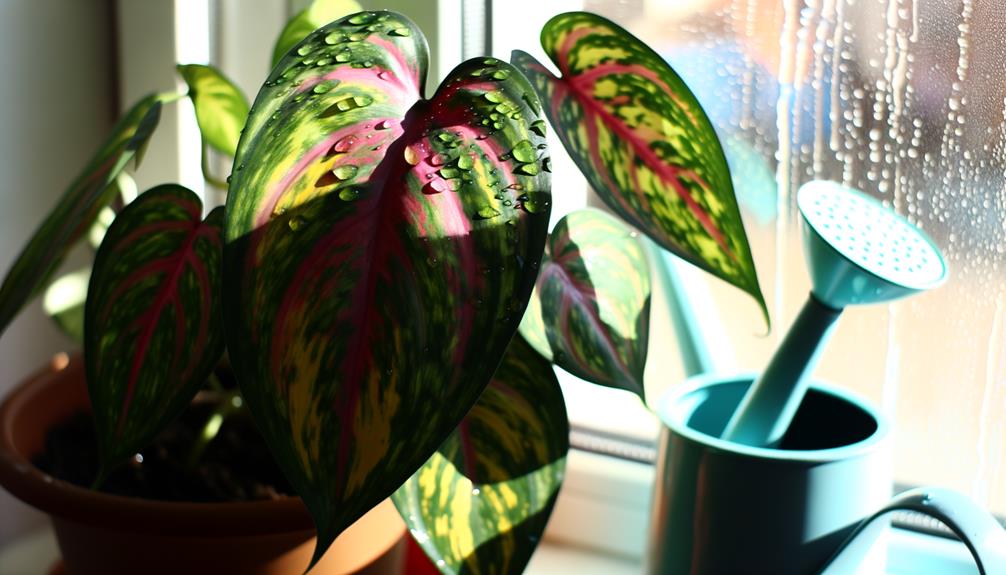
Philodendron hederaceum 'Tricolor' necessitates a precise balance of soil moisture to thrive, requiring consistently damp but not waterlogged conditions. Best moisture levels can be maintained by allowing the top 2-3 centimeters of the substrate to dry out between waterings.
Care must be taken to avoid overwatering, which can lead to root rot, a common issue in Araceae species.
Optimal Moisture Levels
Maintaining ideal moisture levels for Philodendron hederaceum 'Tricolor' necessitates a careful balance, ensuring the substrate remains consistently moist but not saturated to prevent root rot and promote healthy growth. This aroid species thrives under specific hydration regimens that support its physiological demands.
To achieve peak moisture levels, consider the following:
- Substrate Composition: Utilize a well-draining potting mix, incorporating elements like perlite and orchid bark to maintain aeration and moisture retention.
- Watering Frequency: Irrigate when the top inch of the substrate feels dry to the touch, typically once a week, adjusting for environmental conditions.
- Humidity Control: Maintain ambient humidity levels between 60-70% to bolster foliar health, especially in arid climates.
These practices optimize Philodendron hederaceum 'Tricolor's vitality.
Avoiding Overwatering
To prevent overwatering, it is crucial to comprehend the specific hydration needs of Philodendron hederaceum 'Tricolor' and implement a regimen that aligns with its natural growth patterns and substrate preferences. This species thrives in well-draining soil with a consistent moisture level that mimics its native tropical environment. Overwatering can lead to root rot, a common issue in Philodendrons, necessitating a careful balance. The following table delineates key considerations to avoid overwatering:
| Aspect | Recommendation |
|---|---|
| Soil Type | Well-draining, aroid mix |
| Water Frequency | Every 7-10 days, depending on climate |
| Drainage | Pots with drainage holes |
| Environmental Humidity | 60-70% relative humidity |
Adhering to these guidelines guarantees the Philodendron hederaceum 'Tricolor' remains healthy and vibrant.
Soil Preferences
Ideal soil composition for Philodendron hederaceum 'Tricolor' involves a well-draining, aerated mix that retains moisture without becoming waterlogged. This is vital for the health and growth of the plant, optimizing its roots have access to oxygen and do not succumb to root rot.
Key components of an ideal soil mix include:
- Peat moss: Provides moisture retention while maintaining aeration.
- Perlite: Enhances drainage and prevents soil compaction.
- Bark chips: Increases substrate porosity, fostering root development and gas exchange.
These elements collectively create a balanced environment catering to the physiological needs of Philodendron hederaceum 'Tricolor'. The precise blend ensures that the soil remains light and airy, essential for this tropical species' growth and longevity.
Temperature Tolerance
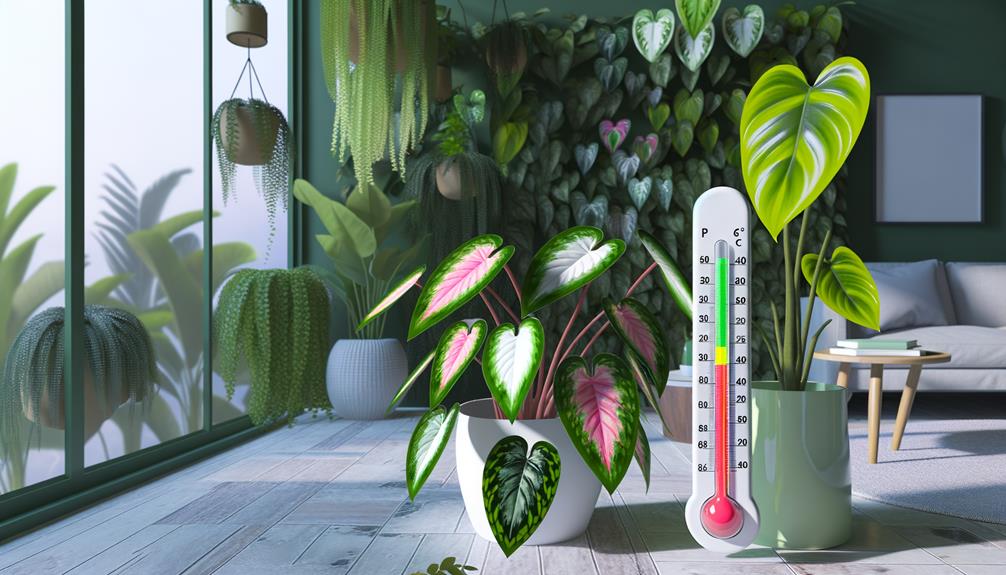
Philodendron hederaceum 'Tricolor' exhibits ideal growth within a temperature range of 18-24°C, aligning with its tropical origins.
Exposure to temperatures below 10°C or above 30°C can induce physiological stress, manifesting in foliar damage and inhibited growth.
Understanding these thermal thresholds is essential for both indoor cultivation and greenhouse management practices.
Optimal Growth Range
Ensuring best growth for Philodendron hederaceum 'Tricolor' necessitates maintaining a temperature range between 18°C and 27°C, as deviations from this range can adversely affect physiological processes and overall plant health. This species, native to tropical regions, thrives in environments where temperatures are consistently moderate.
Within this optimal range, several key physiological benefits can be observed:
- Photosynthetic Efficiency: The plant's chlorophyll functions at its peak, enhancing energy conversion.
- Cellular Respiration: The metabolic rate remains steady, supporting robust growth and development.
- Transpiration Rates: Water movement through the plant is balanced, preventing both dehydration and waterlogging.
Maintaining these temperatures is essential for sustaining the vibrant variegation and overall vigor characteristic of Philodendron hederaceum 'Tricolor.'
Extreme Temperature Risks
Exposure to temperatures outside the ideal range of 18°C to 27°C can result in significant physiological stress for Philodendron hederaceum 'Tricolor', potentially compromising its metabolic functions and ornamental value. Extreme temperature fluctuations, whether excessive heat or cold, can lead to cellular damage, impaired photosynthesis, and reduced nutrient uptake. Prolonged exposure to temperatures below 10°C can induce chilling injury, while temperatures above 30°C may cause heat stress. Both conditions lead to leaf discoloration, wilting, and eventual necrosis.
| Temperature Range | Physiological Impact | Visual Symptoms |
|---|---|---|
| Below 10°C | Chilling Injury | Leaf browning |
| 10°C – 18°C | Less Than Ideal Growth | Slow growth |
| 18°C – 27°C | Best Range | Healthy foliage |
| 27°C – 30°C | Heat Stress Risk | Wilting |
| Above 30°C | Severe Heat Stress | Leaf necrosis |
Understanding these temperature thresholds is essential for maintaining the plant's health and aesthetic appeal.
Humidity Levels
Maintaining ideal humidity levels is crucial for the thriving growth of Philodendron hederaceum 'Tricolor', which prefers a relative humidity of 60-80% to prevent desiccation and promote vigorous foliage development. Consistent humidity levels are essential to mitigate issues such as leaf browning and reduced photosynthetic efficiency.
To ensure best humidity levels, consider the following:
- Humidifiers: Employing a humidifier in the vicinity can maintain the necessary humidity levels.
- Pebble Trays: Placing the plant on a tray filled with water and pebbles can facilitate evaporative humidity.
- Misting: Regularly misting the plant can provide temporary increases in humidity, though this is less consistent.
Fertilization Tips
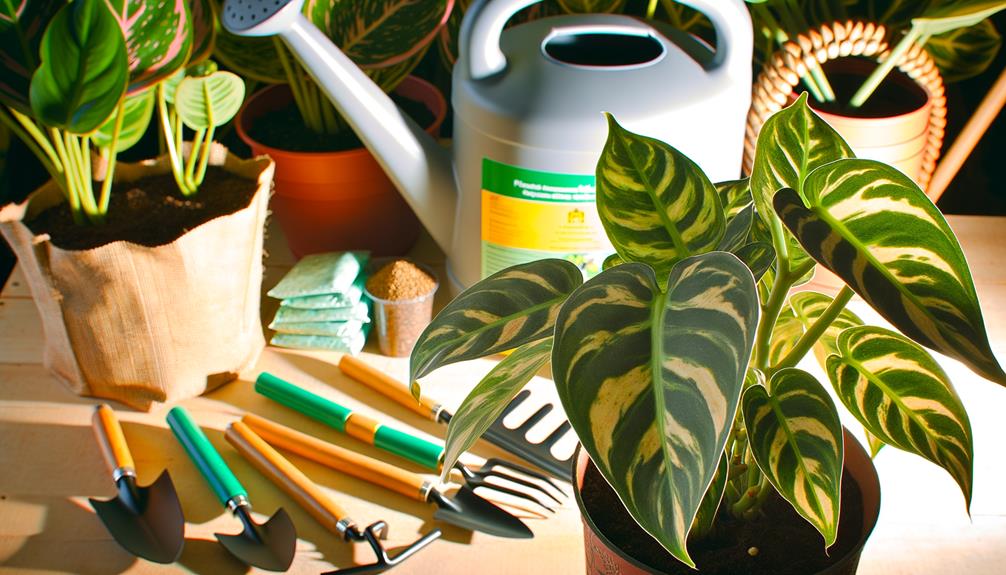
Perfect fertilization of Philodendron hederaceum 'Tricolor' necessitates the application of a balanced, water-soluble fertilizer with an N-P-K ratio of 20-20-20, administered every other month during the active growing season. This guarantees optimal nutrient availability for vigorous growth and variegation maintenance.
Throughout the dormancy period, decrease fertilization frequency to prevent nutrient accumulation and potential root damage. Dilute the fertilizer to half the suggested strength to avoid over-fertilization, which can result in phytotoxicity.
Monitoring the plant's growth and foliar coloration will help in adjusting the fertilization regimen as needed. Sufficient micronutrients like iron (Fe), magnesium (Mg), and calcium (Ca) are also essential for preventing deficiencies and promoting overall plant health.
Propagation Methods
Propagation of Philodendron hederaceum 'Tricolor' is mainly achieved through stem cuttings, which maintains genetic consistency and preserves the plant's variegated characteristics. This method guarantees that the desirable traits, such as the tricolor foliage, are reliably replicated in new plants.
To successfully propagate, follow these steps:
- Select a Healthy Stem: Choose a stem with at least two nodes and healthy variegated leaves. Nodes are essential as they contain the meristematic tissue necessary for root and shoot development.
- Cut and Prepare: Using sterilized pruning shears, make a clean cut just below a node. Remove any leaves near the cut end to prevent rotting when placed in the growing medium.
- Rooting: Place the cutting in water or a well-draining propagation mix. Keep in a humid environment to encourage root formation.
Conclusion
Philodendron hederaceum 'Tricolor' displays a unique botanical tapestry, with its variegated leaves serving as a metaphorical mosaic of nature's artistry.
Adaptable to various light conditions yet thriving in bright, indirect light, this species mirrors a resilient scholar who excels across diverse disciplines.
Optimal growth requires balanced hydration, temperatures between 65-80°F, and humidity levels above 60%.
Propagation through stem cuttings ensures its lineage continues, much like the dissemination of knowledge through generations.
This plant epitomizes both aesthetic appeal and biological resilience.

